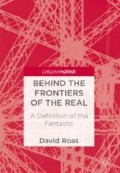Abstract
As will have become clear throughout the preceding chapters, the definition of the fantastic that I am proposing is clearly pragmatic, as it fundamentally depends on the effect that the fantastic fiction inspires in its receiver, beyond any thematic, structural, formal or even stylistic concerns.
At the edges of things we do not fully comprehend we invent fantastic tales to suggest hypotheses or to share the vertigo of our bafflement with others.
Adolfo Bioy Casares
Access this chapter
Tax calculation will be finalised at checkout
Purchases are for personal use only
Notes
- 1.
Nancy B. Traill’s approach is very different: departing from the theory of possible worlds, she describes the fantastic as a “universal aesthetic category” that is manifested through any type of artistic expression: “It may be a play, short story, novel, ballad; we may find it in the form of a painting or a statue, or perhaps a symphony or an opera” (1996: 7).
- 2.
Bibliography
Critical Works
Attebery, Brian. 1992. Strategies of Fantasy. Bloomington: Indiana University Press.
Berthelot, Francis. 2006. Genres et sous-genres dans les littératures de l’imaginaire. http://www.vox-poetica.org/t/lna/FB%20Genres%20imaginaire.pdf
Bozzetto, Roger. 1992. L’obscur objet d’un savoir. Fantastique et Science- Fiction: deux littératures de l’imaginaire. Aix-en-Provence: Publications de l’Université de Provence.
———. 2002. El sentimiento de lo fantástico y sus efectos. In Lo fantástico: literatura y subversión, ed. David Roas, 35–40. Monograph Issue of Journal Quimera, 218–219.
Cornwell, Neil. 1990. The Literary Fantastic: From Gothic to Postmodernism. London: Harvester Wheatsheaf.
Furtado, Filipe. 1980. A construção do fantástico na narrativa. Lisboa: Horizonte.
García, Flavio 2012. Quando a manifestação do insólito importa para a crítica literaria. In Vertentes teóricas e ficcionais do Insólito, Flavio García and María Cristina Batalha (coords.), 13–29. Rio de Janeiro: Caetés.
———. 2013. Discursos fantásticos de Mia Couto. Rio de Janeiro: Dialogarts.
Hume, Kathryn. 1984. Fantasy and Mimesis: Responses to Reality in Western literature. London: Methuen.
Rabkin, Eric. 1976. The Fantastic in Literature. Princeton: Princeton University Press.
Steimberg, Alejo Gabriel. 2013. Literaturas de la certeza y de la duda ontológica. Propuesta clasificatoria para la ficción distanciada. Brumal. Revista de Investigación sobre lo Fantástico/Brumal. Research Journal on the Fantastic I (1): 115–134.
Traill, Nancy B. 1996. Possible Worlds of the Fantastic: The Rise of the Paranormal in Fiction. Toronto-Buffalo-London: University of Toronto Press.
Author information
Authors and Affiliations
Rights and permissions
Copyright information
© 2018 The Author(s)
About this chapter
Cite this chapter
Roas, D. (2018). Conclusions. In: Behind the Frontiers of the Real. Palgrave Pivot, Cham. https://doi.org/10.1007/978-3-319-73733-1_7
Download citation
DOI: https://doi.org/10.1007/978-3-319-73733-1_7
Published:
Publisher Name: Palgrave Pivot, Cham
Print ISBN: 978-3-319-73732-4
Online ISBN: 978-3-319-73733-1
eBook Packages: Literature, Cultural and Media StudiesLiterature, Cultural and Media Studies (R0)

